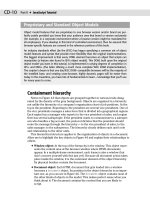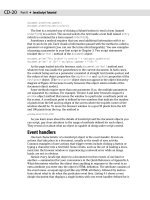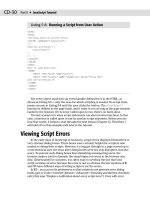JavaScript Bible, Gold Edition part 82 potx
Bạn đang xem bản rút gọn của tài liệu. Xem và tải ngay bản đầy đủ của tài liệu tại đây (178.33 KB, 10 trang )
658
Part III ✦ Document Objects Reference
The start property governs which number or letter begins the sequence of
leading characters for nested LI items. If the
TYPE attribute specifies numbers, then
the corresponding number is used; if it specifies letters, then the letter of the alpha-
bet corresponding to the number becomes as the starting character. You can
change the numbering in the middle of a sequence via the
LI.value property.
It is an extremely rare case that requires you to modify this property for an
existing OL element. But if your script is creating a new element for a segment of
ordered list items that has some other content intervening from an earlier OL ele-
ment, you can use the property to assign a starting value to the OL group.
Example on the CD-ROM
Related Items: type, LI.value properties.
type
Value: String Constant Read/Write
NN2 NN3 NN4 NN6 IE3/J1 IE3/J2 IE4 IE5 IE5.5
Compatibility ✓✓✓✓
An OL element can use any of five different numbering schemes. Each scheme
has a type code, whose value you can use for the
type property. The following
table shows the property values and examples:
Value Example
A A, B, C,
a a, b, c,
I I, II, III,
i i, ii, iii,
1 1, 2, 3,
The default value is 1. You are free to adjust the property after the table has ren-
dered, and you can even stipulate a different type for specific LI elements nested
inside (see the
LI.type property). If you want to have further nesting with a differ-
ent numbering scheme, you can nest the OL elements and specify the desired type
for each nesting level, as shown in the following HTML example:
<OL TYPE=”A”>
<LI>One
<LI>Two
On the
CD-ROM
OL.type
659
Chapter 27 ✦ Table and List Objects
<LI>Three
<OL TYPE=”a”>
<LI>Sub One
<LI>Sub Two
<LI>Sub Three
</OL>
<LI>Four
</OL>
Indenting the HTML is optional, but it may help you to keep the nesting straight.
Example on the CD-ROM
Related Items: start, UL.type, LI.type properties.
UL Element Object
For HTML element properties, methods, and event handlers, see Chapter 15.
Properties Methods Event Handlers
compact†
type
†See OL Element Object.
Syntax
Accessing UL element object properties and methods:
(IE4+) [window.]document.all.elemID.property | method([parameters])
(IE5+/NN6) [window.]document.getElementById(“elemID”).property |
method([parameters])
NN2 NN3 NN4 NN6 IE3/J1 IE3/J2 IE4 IE5 IE5.5
Compatibility ✓✓✓✓
About this object
The UL (unordered list) element is a container of LI (list item) elements. An
unordered list means that the list items have no sequence and are preceded by sym-
bols that don’t signify any particular order. The few element-specific attributes are
being deprecated in favor of style sheet definitions. For the sake of backward com-
patibility with existing content, however, it is likely that many future generations of
browsers will continue to support these deprecated attributes. These attributes are
therefore available as properties of the element object.
On the
CD-ROM
UL
660
Part III ✦ Document Objects Reference
Most of the special appearance of a list (notably indentation) is handled auto-
matically by the browser’s interpretation of how an ordered list should look. You
have control over the three possible characters that precede each item.
Properties
type
Value: String Constant Read/Write
NN2 NN3 NN4 NN6 IE3/J1 IE3/J2 IE4 IE5 IE5.5
Compatibility ✓✓✓✓
A UL element can use any of three different leading characters. Each character
type has a type code whose value you can employ for the
type property. Property
values are
circle, disc, and square. The difference between a circle and disc is
that the
circle is unfilled, while the disc is solid. The default value is disc.
Example on the CD-ROM
Related Items: OL.type, UL.type properties.
LI Element Object
For HTML element properties, methods, and event handlers, see Chapter 15.
Properties Methods Event Handlers
type
value
Syntax
Accessing LI element object properties and methods:
(IE4+) [window.]document.all.elemID.property | method([parameters])
(IE5+/NN6) [window.]document.getElementById(“elemID”).property |
method([parameters])
NN2 NN3 NN4 NN6 IE3/J1 IE3/J2 IE4 IE5 IE5.5
Compatibility ✓✓✓✓
On the
CD-ROM
LI
661
Chapter 27 ✦ Table and List Objects
About this object
An LI (list item) element contains the HTML that is displayed for each item
within an OL or UL list. Note that you can put any HTML you want inside a list item,
including images. Attributes and properties of this element enable you to override
the specifications declared in the OL or UL containers (except in IE/Mac).
Properties
type
Value: String Constant Read/Write
NN2 NN3 NN4 NN6 IE3/J1 IE3/J2 IE4 IE5 IE5.5
Compatibility ✓✓✓✓
Because either an OL or UL container can own an LI element, the type property
accepts any of the values that you assign to the
type properties of both the OL and
UL element objects. See the
OL.type and UL.type properties earlier in this chapter
for lists of those values.
Exercise caution, however, if you attempt to mix and match types. For example, if
you try to set the
LI.type property of an LI element to circle inside an OL ele-
ment, the results vary from browser to browser. NN6, for example, follows your
command; however, IE may display some other characters.
Example on the CD-ROM
Related Items: OL.type, UL.type properties.
value
Value: Integer Read/Write
NN2 NN3 NN4 NN6 IE3/J1 IE3/J2 IE4 IE5 IE5.5
Compatibility ✓✓✓✓
The value property governs which number or letter is used for the current list
item inside an ordered list. Employ this attribute and property to override the natu-
ral progression. Because these sequence characters can be letters, numbers, or
Roman numerals, the integer you specify for this property is converted to the num-
bering scheme in force by the LI or OL element’s
type property.
On the
CD-ROM
LI.value
662
Part III ✦ Document Objects Reference
Example on the CD-ROM
Related Item: OL.start property.
DL, DT, and DD Element Objects
For HTML element properties, methods, and event handlers, see Chapter 15.
Properties Methods Event Handlers
compact†
†See OL Element Object.
Syntax
Accessing DL, DT, and DD element object properties and methods:
(IE4+) [window.] document.all.elemID.property | method([parameters])
(IE5+/NN6+) [window.] document.getElementById(“elemID”). property |
method([parameters])
NN2 NN3 NN4 NN6 IE3/J1 IE3/J2 IE4 IE5 IE5.5
Compatibility ✓✓✓✓
About these objects
Three elements — DL, DT, and DD — provide context and (optionally) formatting
for definitions in a document. The DL element is the outer wrapper signifying a defi-
nition list. Each definition term should be inside a DT element, while the definition
description should be in the nested DD element. The HTML for a simple definition
list has the following structure:
<DL>
<DT>First term
<DD>First term’s definition
<DT>Second term
<DD>Second term’s definition
</DL>
While there are no specific requirements for rendering definition lists by conven-
tion, the term and description are usually on different lines with the description
indented.
All three of these elements are treated as element objects, sharing the same
properties, methods, and event handlers of generic element objects. The only one
On the
CD-ROM
DL
663
Chapter 27 ✦ Table and List Objects
of the three that has anything special is the DL element, which has a compact prop-
erty. IE4+ for Windows does respond to this attribute and property by putting the
description and term on the same line if the term is shorter than the usual indenta-
tion space of the description.
DIR and MENU Element Objects
For HTML element properties, methods, and event handlers, see Chapter 15.
Properties Methods Event Handlers
compact†
†See OL Element Object.
Syntax
Accessing DIR and MENU element object properties and methods:
(IE4+) [window.]document.all.elemID.property | method([parameters])
(IE5+/NN6) [window.]document.getElementById(“elemID”). property |
method([parameters])
NN2 NN3 NN4 NN6 IE3/J1 IE3/J2 IE4 IE5 IE5.5
Compatibility ✓✓✓✓
About these objects
The DIR and MENU elements are treated in modern browsers as if they were UL
elements for unordered lists of items. Both elements are deprecated in HTML 4.0;
yet, because they are acknowledged in that standard, they are also acknowledged
in the W3C DOM (and the IE DOM, too). Originally intended to assist in creating sin-
gle and double columns of text (long since supplanted by tables), usage of these
elements has fallen out of favor and is discouraged.
✦✦✦
DIR
and Other
Environment
Objects
C
lient-side scripting primarily focuses on the document
inside a browser window and the content of the docu-
ment. As discussed in Chapter 16, the window, too, is an
important part of how you apply JavaScript on the client. But
stepping out even one more level is the browser application
itself. Scripts sometimes need to know about the browser and
the computing environment in which it runs so that they can
tailor dynamic content for the current browser and operating
system.
To that end, browsers provide objects that expose as much
about the client computer and the browser as is feasible within
accepted principles of preserving a user’s privacy. In addition
to providing some of the same information that CGI programs
on the server receive as environment variables, these browser-
level objects also include information about how well equipped
the browser is with regard to plug-ins and Java. Another object
defined for NN4+ and IE4+ reveals information about the user’s
video monitor, which may influence the way your scripts calcu-
late information displayed on the page.
The objects in this chapter don’t show up on the document
object hierarchy diagrams, except as freestanding groups (see
Appendix A). The IE4+ object model, however, incorporates
these environmental objects as properties of the
window
object. Because the window reference is optional, you can
omit it for IE and wind up with a cross-browser, compatible
script in many cases.
Where the IE (for Windows anyway) and NN environments
diverge significantly is in the way scripts can find out whether
a particular plug-in or support for a particular MIME type is
available in the current browser. As you learn in this chapter,
28
28
CHAPTER
✦✦✦✦
In This Chapter
Determining which
browser the user has
Branching scripts
according to the
user’s operating
system
Detecting plug-in
support
✦✦✦✦
666
Part III ✦ Document Objects Reference
the IE for Windows methodology can be a bit roundabout. And yet the Macintosh
version of IE5+ has adopted the approach initiated by NN3. Go figure.
clientInformation Object (IE4+) and navigator
Object (All)
Properties Methods Event Handlers
appCodeName javaEnabled()
appMinorVersion preference()
appName taintEnabled()
appVersion
browserLanguage
cookieEnabled
cpuClass
language
mimeTypes
onLine
oscpu
platform
plugins
product
productSub
securityPolicy
systemLanguage
userAgent
userLanguage
userProfile
vendor
vendorSub
Syntax
Accessing clientInformation and navigator object properties and methods:
(All) navigator.property | method()
(IE4+/NN6) [window.]navigator.property | method()
(IE4+) [window.]clientInformation.property | method()
navigator
667
Chapter 28 ✦ The Navigator and Other Environment Objects
About this object
In Chapter 16, I repeatedly mention that the window object is the top banana of
the document object hierarchy. In other programming environments, you likely can
find a level higher than the window — perhaps referred to as the application level.
You may think that an object known as the
navigator object is that all-encompass-
ing object. That is not the case, however.
Although Netscape originally invented the
navigator object for the Navigator 2
browser, Microsoft Internet Explorer also supports this object in its object model.
For those who exhibit partisan feelings toward Microsoft, IE4+ provides an alternate
object —
clientInformation — that acts as an alias to the navigator object. You
are free to use the IE-specific terminology if your development is intended only for
IE browsers. All properties and methods of the
navigator and
clientInformation objects are identical. In the rest of this section, all references
to the
navigator object also apply to the clientInformation object.
Be aware that the number of properties for this object has grown with virtually
every browser version. Moreover, other than some basic items that have been
around since the early days, most of the more recent properties are browser-spe-
cific. Observe the compatibility ratings for each of the following properties very
carefully.
Most of the properties of the
navigator object deal with the browser program
the user runs to view documents. Properties include those for extracting the ver-
sion of the browser and the platform of the client running the browser. Because so
many properties of the
navigator object are related to one another, I begin this
discussion by grouping four of the most popular ones together.
Properties
appCodeName
appName
appVersion
userAgent
Value: String Read-Only
NN2 NN3 NN4 NN6 IE3/J1 IE3/J2 IE4 IE5 IE5.5
Compatibility ✓✓✓✓ ✓ ✓ ✓✓✓
These four properties reveal just about everything that browser-sniffing code
needs to know about the user’s browser brand, version, and other tidbits. Of these
four, only the last three are particularly valuable. The first property in the list,
appCodeName, defines a class of client that encompasses essentially every standard
browser. The value returned by browsers,
Mozilla, is the code name of the first
browser engine on which NN and IE browsers at one time were based (the NCSA
Mosaic browser). This information does nothing to help your scripts distinguish
among browser flavors, so you can ignore the property. But the other three proper-
ties are the ones with all the goodies.
navigator.appCodeName









